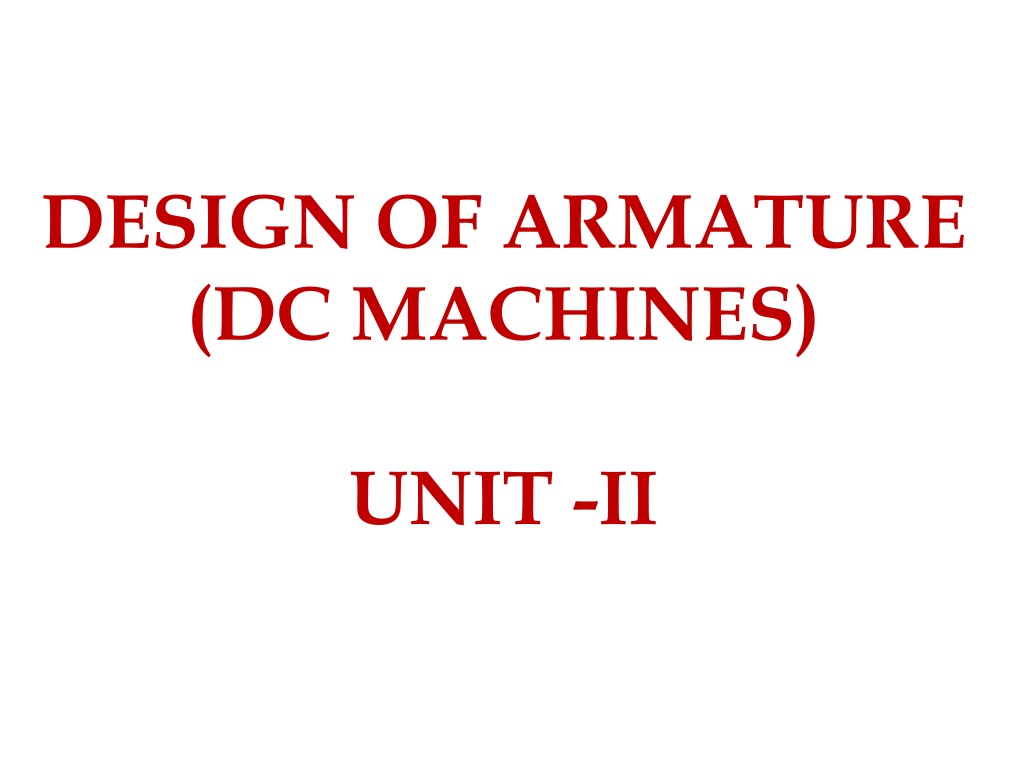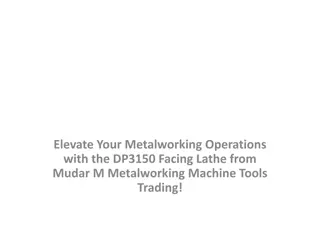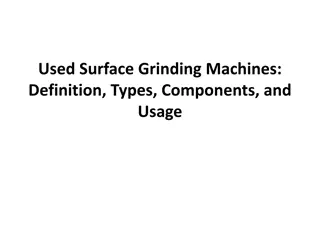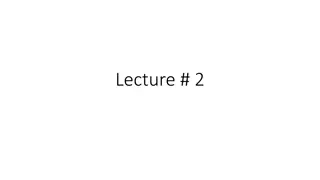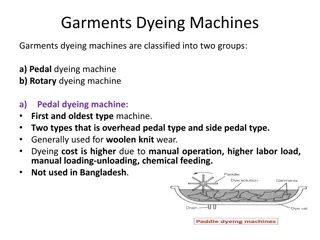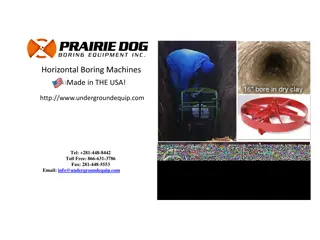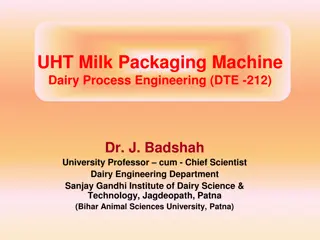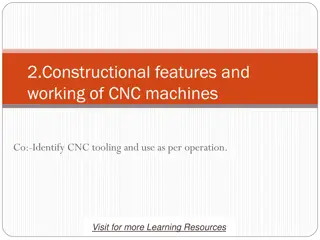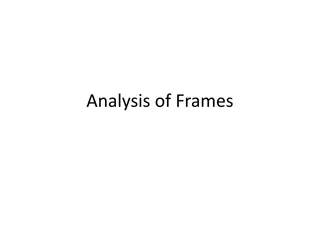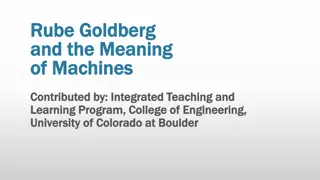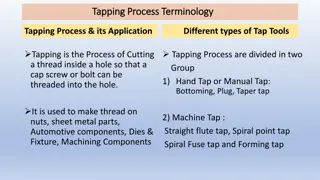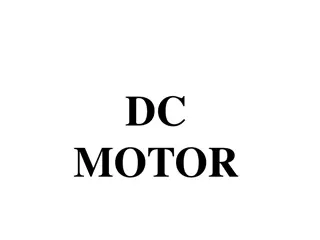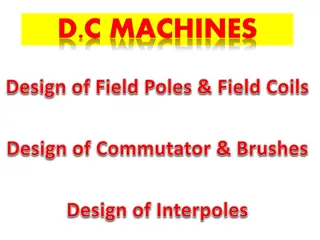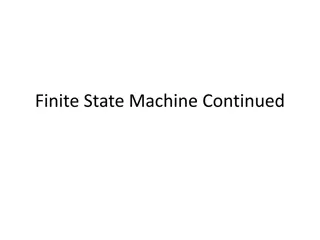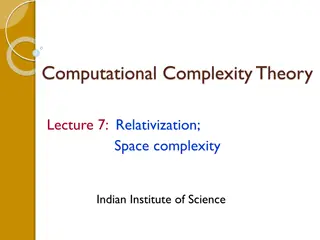Understanding the Design and Elements of Armature in DC Machines
The design of armature in DC machines involves various factors such as armature windings, number of conductors, coils, slots, voltage drop, peripheral speed, and more. Armature winding arrangements play a crucial role in producing electromotive forces through relative motion in a magnetic field. Common terminologies associated with armature windings, like conductors, turns, coils, and coil sides, are essential for a comprehensive understanding of the subject.
Download Presentation

Please find below an Image/Link to download the presentation.
The content on the website is provided AS IS for your information and personal use only. It may not be sold, licensed, or shared on other websites without obtaining consent from the author. Download presentation by click this link. If you encounter any issues during the download, it is possible that the publisher has removed the file from their server.
E N D
Presentation Transcript
DESIGN OF ARMATURE (DC MACHINES) UNIT -II
DESIGN OF ELECTRICAL MACHINES EE 6604 FACULY NAME SHRI.N.B.RAJESH M.E. AP-II/EEED VCET,MADURAI
Design of Armature involves: Choice of Armature Windings No. of armature conductors No. of armature coils No. of armature slots Guide lines for selection of no. of slots Armature Voltage drop Peripheral speed Limiting value of L Limiting value of D Provision of ventilating ducts Iron-stacking factor or stacking factor Slot space factor or space factor Depth of armature core
Introduction The Armature winding of a machine is defined as an arrangement of conductors' design to produce emfs by relative motion in a magnetic field. Electrical machines employ groups of conductors distributed in slots over the periphery of the armature. The groups of conductors are connected in various types of series-parallel combination to form Armature winding. The conductors connected in series so as to increase the voltage rating. They are connected in parallel to increase the current rating.
ELEMENTS OF ARMATURE WINDINGS IN A DC MACHINES
Common Terminologies associated with windings Conductor: The active length of a wire or strip in the slot. Turn: A turn consists of two conductors separated from each other by a pole pitch or nearly so, and connected in series as shown in fig.(a) The conductors forming a turn are kept a pole pitch apart in order that the emf in two are additive to produce maximum resultant emf. N S Conductor Conductor Pole-pitch a) Single turn coil
Coil: A coil may consist of a single turn or may consist of many turns, placed in almost similar magnetic position, connected in series. Coil-Side: A coil consists of two coil sides, which are placed in two different slots, which are almost a pole pitch apart. The group of conductors on one side of the coil form one coil side while the conductors on the other side of the coil situated a pole pitch (or approximately a pole pitch apart) forms the second coil side. N S N S Conductor Conductor Coil side a) Single turn coil b) 3 turns coil
The connections joining the conductors form the end connectors or in the mass,the overhang or end winding. When the coil sides forming a coil are spaced exactly one pole pitch a part they are said to be of full-pitch. However, the coil span may be less than a pole pitch, in which case the coil is described as short pitched or chorded. Overhang C B D Coil-sides Pole-pitch Single turn coil
The angle between centers of adjacent poles is 180o (electrical) 180o electrical = 90o mech 360o electrical = 180o mech N S S N
If coil sides are placed 180o electrical apart, the coil is said to be full-pitch N a a b 180oelec S S b N
DC WINDINGS:- AC WINDINGS:- Simplex & Duplex winding Introduction Lap & Wave windings single layer winding Basic terms related to armature windings Mush winding Dummy coils Double layer winding Equalizer connections Condition of designing D.L.W. Integral slot lap & Wave winding Fractional slot lap& Wave winding
DC WINDINGS Lap Windings Armature windings are mainly of two types lap winding and wave winding. Here we are going to discuss about lap winding. Lap winding is the winding in which successive coils overlap each other. It is named "Lap" winding because it doubles or laps back with its succeeding coils. In this winding the finishing end of one coil is connected to one commutator segment and the starting end of the next coil situated under the same pole and connected with same commutator segment.
Simplex lap winding:- A winding in which the number of parallel path between the brushes is equal to the number of poles is called simplex lap winding.
Duplex lap winding:- A winding in which the number of parallel path between the brushes is twice the number of poles is called duplex lap winding.
Important terms related to lap winding:- If, Z = the number conductors P = number of poles YB = Back pitch (YB = YF 2m) (m=multiplicity of winding) YF = Front pitch (m=1 for simplex lap winding) YC = Commutator pitch (m=2 for duplex lap winding) YA = Average pole pitch YB > YF for progressive lap winding Yc =1 YP = Pole pitch YB <YF for retrogressive lap winding Yc= 1 YR = Resultant pitch Resultant pitch (YR) = YB - YF = 2m
Wave windings:- Wave winding is one type of armature winding. In this winding the end of one coil is connected to the starting of another coil of the same polarity as that of the first coil. This winding forms a wave with its coil, that s why it is named as wave winding. It is also called series winding because its coils are connected in series.
Progressive wave winding:- If after one round of the armature the coil falls in a slot right to its starting slot the winging is called Progressive wave winding.
Retrogressive wave winding If after one round of the armature the coil falls in a slot left to its starting slot the winging is called Retrogressive wave winding.
Important terms related to wave winding:- In simplex wave winding Back pitch(YB) and front pitch (YF) are both odd and are of same sign. Back pitch and front pitch are nearly equals to the pole pitch and may be equal or differ by 2. + for progressive winding - for retrogressive winding. Resultant pitch:- Yr= YB + Yf Commutator pitch :- Yc = Y/2
Dummy coils: The wave winding is possible only with particular number of conductors and poles and slots combinations. Some times the standard stampings do not consist of the number of slots according to the design requirements and hence the slots and conductor combination will not produce a mechanically balanced winding. Under such conditions some coils are placed in the slots, not connected to the remaining part of the winding but only for mechanical balance. Such windings are called dummy coils.
Equaliser: Due to variation in MMF of the field winding, there is a possibility of unequal voltage in armature winding. As certain extra amount of voltage is developed in any of the parallel paths., it will cause flow of circulating current. Due to this extra current, the copper loss will rise. To avoid this, the voltage should be equally distributed. The equaliser is a low resistance conductor which is connected in between two coils of same polarity to equalise the potential among all parallel paths. (Lap winding)
A wave windings requires no equalizer connections. This is true because each path has conductors in series under all poles of the dynamo. Any difference in the lines of the flux from the poles will produce different voltage in the inductors , but both paths will be equally affected and the total induced voltage of each path will always be the same.
